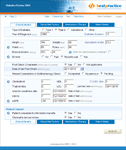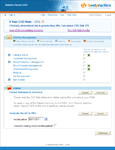Diabetes Review

Introduction
The bestpractice Decision Support Diabetes Annual Review module provides up to date clinical support for health professionals in managing patients’ diabetes. Recommendations for prevention and treatment of diabetes complications are made based on a person’s clinical results and calculated cardiovascular risk. Much of the information required in conducting the annual review is pre-populated from the patient management system allowing a health professional to rapidly determine which details need updating and recording. Recommendations for management are then customised for each patient.
Background
All people in New Zealand with diabetes are entitled to a free diabetes check-up with their general practitioner or practice nurse once a year. The free check-up acts as a reminder to both the patient and health professional that no diabetes care has been missed for the year.
People with diabetes are two to six times more likely to develop cardiovascular disease (CVD) than people without diabetes. The most important forms of CVD are coronary artery disease (leading to heart attacks, angina, and heart failure), cerebrovascular disease (leading to stroke) and peripheral vascular disease (leading to gangrene or ulceration of the feet and legs requiring amputation).
For this reason the bestpractice Annual Diabetes Review includes all the clinical information that contributes to a cardiovascular risk assessment (for more information see the bestpractice modules CVD management and CVD Quick Screen) as well as the additional areas that are important for a patient with diabetes such as an eye check, kidney function and foot check.
How it works
The bestpractice Diabetes Annual Review prompts users to check the regular tests to maintain health and avoid diabetes complications have either been done, or are booked to be done. It also calculates and displays a person’s absolute CVD risk so this assessment is completed simultaneously.
The form ensures the following checks are up-to-date:
- Blood pressure
- An HBA1c level (this checks the average blood glucose levels over the previous 6 weeks)
- Blood lipid levels (including cholesterol)
- Height and weight
- Kidney function
- The retinas of the eyes within the last two years
- The sensation and circulation of the feet
Another important function of the free Diabetes Annual Review is to collect nationwide information about the numbers of people with diabetes and the state of their health. With the patient’s consent to being on the programme, the aggregated statistics can be made available to health planners and groups keen to lobby for better services in diabetes care. However individual information cannot be identified so privacy is protected.
Once the user has checked the patient’s clinical risk factors and current therapy are correctly recorded in the medical record, the Decision Support system then calculates and displays a person’s current CVD risk based on the results of the latest assessment. It then automatically saves this in a standard way directly to the patient’s medical record.
Having calculated a person’s CVD Risk, the bestpractice Decision Support Annual Review then lists the management options for each patient and the extent to which each would be recommended. These vary from Highly Recommended actions, i.e. those where failure to choose this action could strongly impact patient health, through to Strongly Discouraged actions where choosing this action could impair patient health.
The bestpractice Diabetes Annual Review makes recommendations based on the New Zealand Cardiovascular Guidelines Handbook. These include the recommended interventions, goals and follow-up for each patient.
The module then facilitates this management as appropriate. For example:
- Lifestyle advice in the form of patient information leaflets,
- Guidelines on management of risk factors such as cholesterol, blood pressure or glycaemic control.
- The prescription of renal protection or
- A pre-populated Referral form to Cardiology, Podiatry or for retinal screening,
Additional resources are also available to the user from direct links on a drop-down menu. These include links to the Diabetes New Zealand website, The Diabetic Foot, BPACnz and Your Heart Forecast websites. The references for the content of the module are listed and a selection of Frequently Asked Questions.
The New Zealand Guidelines Group Interventions Guideline is available already customised for the current patient, and the CVD Risk Tables can be viewed with the relevant value for this patient plotted. A unique tool is the CVD Risk Modifier which is a clear demonstration to patients of how their CVD risk will change as they age and/or progress towards their clinical targets.
For those patients who wish to keep their own copy of the results of their check-up, a Patient Summary can be printed for them at the same time as the information is saved in the medical record.
The module can also send a recall to the Practice Management System so a reminder is sent to the patient when their next check-up is due.
External links
- BPACNZ
- Diabetes New Zealand
- The Diabetic Foot
- Your Heart Forecast provided by the Heart Foundation
Featured module

The INR Monitoring module utilises a formula developed by Ryan et al which assists clinicians adjust oral anticoagulant doses in patients. It also recommends the time interval for the next follow up visit and prints a Patient Dose calendar if required.
For more modules see the full list of standard modules.
Latest News
ACC18 Enhancements - Effective 27 November
Calendar, Printing and ACC Identifiers
In response to feedback, the online ACC18 continues to launch enhancements; the following will be available from 27 November.
Fitness for Work Tab - Calendar: Moving the mouse over the calendar for longer periods has been made easier.
Declaration Tab - ACC Identification: There will be a reduction in the number of identifiers from five to four; no direct impact on the Provider.
If you are one of the over 2000 Practitioners who regularly use the online ACC18; thank you. If you are not then now would be a good time to begin, noting that additional return to work assistance for patients is offered solely through this online form. Self service for setting up and using the online ACC18 is available at www.acc.co.nz (use keyword eACC18 Self Service). However, feel free to contact ACC at 0800 222 994 or ebusinessinfo@acc.co.nz for more personalised support.
Most Popular Modules
The five most popular modules in June were:
- Patient Prompt
- The Common Form
- e-Referral System
- ACC 18 Form
- CVD Quick Screen
To see more, go to the Statistics page.
Getting Started guide
The Getting Started guide is a good place to start if you are new to bestpractice Decision Support. The articles in the guide provide a quick and focussed introduction to the areas of most interest to new users of bestpractice.
About BPAC Inc
bestpractice Decision Support is produced by BPAC Inc. To find out more about us, click here.









